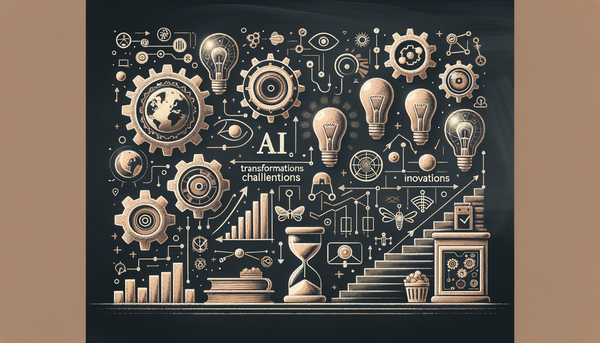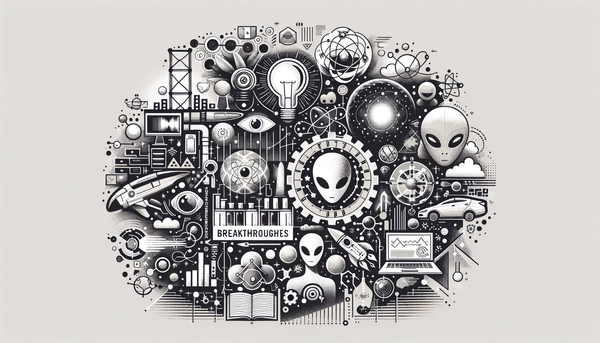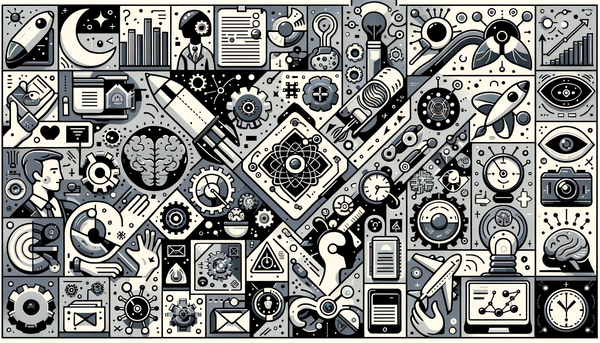Intel and the Evolution of AI in technology
Artificial Intelligence on the Edge: Revolutionizing Industries, Transforming Creativity, and Redefining the Future
This comprehensive exploration examines how AI's disruptive potential is being harnessed by tech titans at global conferences, driving innovations in consumer products and semiconductor sectors, reshaping workforce dynamics, and even inspiring a creative renaissance in animated storytelling. By dissecting opinions from industry leaders, breakthroughs like AI-powered augmented reality experiences, rapid adoption of AI chatbots, and transformational leadership at giants like Intel, we paint a picture of an evolving landscape where AI not only augments human productivity but also challenges traditional boundaries in business and creativity.
AI as a Transformative Force in Business and Innovation
At recent high-profile events such as CNBC’s CONVERGE LIVE in Singapore, technology leaders have passionately discussed artificial intelligence’s transformative role in modern society. The discussions reflected a convergence of ideas about technology’s potential to boost productivity, generate new markets, and pave the way for innovative business models that defy the traditional norms.
During the event, influential figures like Alibaba's Chairman Joe Tsai brought forward the idea that AI could potentially unlock a market worth about $10 trillion globally by dramatically enhancing human efficiency. Tsai’s reference to the “DeepSeek moment” is particularly notable—an analogy for a pivotal breakthrough in open-source AI development. This paradigm shift enables smaller companies and emerging entrepreneurs to access and implement cutting-edge AI technologies without the colossal financial burden typically associated with proprietary innovations.
"Innovation is not solely the domain of those with deep pockets; it is the byproduct of open exchange and collective creativity," said an enthusiastic tech leader at the event, echoing ideas similar to those that have been reiterated in various AI.Biz posts like Humans Who Don't Embrace AI Will Be Replaced by AI.
Complementing Tsai's forward-looking perspective, thought leaders from other corporations added nuanced provisos to the discussion. For instance, Microsoft's Dean Carignan emphasized the need to anchor AI developments in human-centric values. His advocacy for "human-centered AI" suggests that while AI should automate mundane tasks, it must also serve to enhance, rather than replace, human creativity and empathy.
Additionally, executives from Cisco and HP, including Guy Diedrich and Ganesha Rasiah respectively, highlighted the importance of building trust and security within AI-powered systems. The rapid acceleration of AI solutions comes with increased security challenges and the need for agile workforce upskilling. Diedrich’s insights stressed that while technological sophistication is crucial, it should never outpace ethical considerations and rigorous security protocols. Meanwhile, Rasiah’s cautious optimism pointed to a future where job roles evolve rather than diminish, paving the way for entirely new positions in the digital economy.
Investment perspectives were not left aside; Salesforce's Marc Benioff cautioned against the perils of "groupthink" in the tech arena, urging investors and businesses to critically evaluate when and where to allocate resources for massive infrastructural developments. His warnings reverberated through the event, reminding stakeholders that strategic vision must accompany financial commitment. Kamal Bhatia from Principal Asset Management further reinforced that innovation can thrive amid financial constraints, especially with platforms like DeepSeek lowering the barriers to entry.
Such insights indicate that as industries grapple with AI's implications, the need for a balanced approach that fuses technological advancements with human intuition has never been more critical. These discussions—rich with both promise and prudent warnings—set the stage for a future where businesses must not only adapt but also innovate responsibly.
Augmented Reality and Creative Innovation: The Case of Snapchat
Beyond traditional business applications, AI's cutting edge is also revolutionizing consumer technologies, particularly in augmented reality (AR). Snapchat has emerged as a frontrunner in this creative renaissance by introducing its AI-generated Lenses designed exclusively for its premium subscribers. This initiative, powered by an innovative in-house generative video model, represents a leap forward in blending artificial intelligence with everyday social media interactions.
The new AI Video Lenses—featuring playful companions like “Raccoon” and “Fox,” and the visually stunning “Spring Flowers” lens—offer users a dynamic and immersive experience. These lenses not only animate digital characters in real-time but also integrate smoothly into user workflows by processing content in the background. This exemplifies how AI is effectively bridging the gap between technology and art, enhancing user engagement and paving the way for novel content creation techniques.
This evolution in AR technology is a practical demonstration of how AI can enhance creativity. While Instagram has also experimented with similar features aimed at enriching user experiences, Snapchat’s early moves have positioned it as a leader in AI-augmented storytelling. By enabling real-time, lifelike interactions between users and digital characters, these enhanced AR features have sparked significant interest and promised a new paradigm for social media engagement.
Innovations like these underscore a broader trend where technology is democratizing creative expression. The blending of AI with AR not only entertains but also inspires users to explore imaginative ways to communicate and connect. It is a clear example of how technological innovation continues to intersect with creative industries, blurring the lines between art and engineering.
Semiconductor Industry and the AI Surge: Intel’s Transformation
Artificial intelligence’s rapid advances are not limited to software and consumer applications; they extend deep into hardware innovation. A striking case is Intel, a semiconductor giant that recently welcomed a new CEO, Lip-Bu Tan, amidst challenging market conditions and significant restructuring.
As detailed in a recent TechCrunch article, Intel's journey under its former CEO Pat Gelsinger was marked by ambitious modernization efforts, primarily through the IDM strategy that sought to reinvent manufacturing through significant investments, including a $20 billion facility build in Arizona. However, this phase also witnessed setbacks, such as the aborted $5.4 billion acquisition of Tower Semiconductor, coupled with a drastic stock downturn and workforce reductions.
The challenge for Intel—and indeed, for the broader semiconductor industry—is monumental: to integrate AI capabilities into manufacturing and design processes in an increasingly competitive landscape. Under CEO Lip-Bu Tan’s leadership, there have been early signs of promise. With the support of nearly $8 billion in grants under the U.S. Chips and Science Act and the rising popularity of products like the Arc B580 graphics card, Intel aims to recalibrate its strategic focus. This redirection is not merely about recovery; it is also about seizing the AI market opportunity, which is reshaping hardware demands.
One could draw an interesting parallel here: just as AI is revolutionizing the way companies interact with data and creativity, it is equally driving the evolution of the very hardware that powers these innovations. By rethinking manufacturing capabilities and fostering a robust domestic production ecosystem, Intel's strategic overhaul may well serve as a bellwether for the semiconductor industry at large.
This intersection of AI and hardware innovation is a quintessential example of how technology continuously redefines traditional sectors. As companies like Intel realign their operational models to adapt to the AI onslaught, we may witness accelerated improvements in processing power, energy efficiency, and ultimately, smarter devices that power not just computers but entire ecosystems of connected technologies.
Mainstream AI Adoption: Chatbots and Everyday Integration
The growth of AI is also prominently reflected in its pervasive adoption across everyday life. A recent survey reported by NBC News reveals that over half of American adults have interfaced with AI chatbots. This statistic, while perhaps not entirely surprising, offers a glimpse into how quickly AI technologies have woven themselves into the fabric of daily routines.
Chatbots, capable of understanding context and providing personalized responses, have gradually become indispensable across customer service, healthcare, education, and even entertainment. Whether a consumer is seeking assistance with an online order or a quick answer to a complex query, the integration of AI-driven chatbots has allowed businesses to scale their support systems without sacrificing quality.
This widespread usage hints at the broader societal impact of AI. In many ways, the ubiquity of chatbots is the tip of the iceberg—a sign of deeper transformations in how people and technology interact. These digital assistants represent more than just convenience; they signal a shift towards a future where artificial intelligence assists in decision-making, problem-solving, and daily management of tasks. The pace at which these tools have been adopted is a testament to the robustness of modern AI algorithms and their potential to serve as the backbone of future human-machine collaborations.
While some remain cautious about the long-term implications of such integration, the trend clearly indicates that AI is paving the way for smarter, more intuitive user interfaces. In many respects, these advancements are aligned with the philosophy of "human-centered AI" promoted by industry visionaries, ensuring that technological advancements complement rather than supplant human interaction.
Blending Creativity with Technology: The Rise of AI in Animation
In an inspiring turn towards creative industries, the world of animation is also experiencing a renaissance fueled by artificial intelligence. A notable project in this domain is the upcoming AI-driven animated feature, "Critterz," being developed by the creative minds behind the endearing "Paddington in Peru." This venture is set to merge the wonder of storytelling with the precision and versatility of AI, promising to capture the hearts of audiences across generations.
The project, as reported by Animation Magazine, marries advanced generative models with traditional animation techniques, reflecting an exciting future where creativity is elevated by technology. The AI component in "Critterz" not only automates routine aspects of animation production but also provides novel tools for narrative development. Imagine dynamic characters whose expressions and movements are fine-tuned in real-time, or landscapes that evolve with the storyline—such possibilities underscore how AI can be a powerful tool for creative expression.
This effort is reminiscent of how technology continuously reshapes genres. In the words of Catherynne M. Valente, an observation echoed in one of my favorite literary reflections: "I can communicate in 6,909 living and dead languages. I can have more than fifteen billion simultaneous conversations..." Although the context here is different, it reminds us that the interplay between human creativity and technological advancement can produce wonders beyond our current imagination.
For a long time, the animation industry has thrived on a blend of technical skill and artistic vision. With AI now entering the fray, artists and storytellers are afforded a new canvas on which to craft immersive experiences. This integration aims not only to streamline production but also to push the envelope of narrative innovation.
As "Critterz" gears up for its debut, it represents a microcosm of the broader trend: art and technology are converging to redefine the limits of storytelling. The project is a reminder that AI is not just a tool for efficiency—it is also a wellspring of creative possibility that has the potential to revolutionize entire industries.
Cross-Industry Reflections and Strategic Considerations
The narratives across multiple sectors—from enterprise AI adoption and semiconductor evolution to consumer-facing applications and creative endeavors—illustrate that artificial intelligence is a multi-faceted revolution. Industry leaders are not only advancing technological frontiers but are also rethinking how industries organize, operate, and connect with society at large. As highlighted during the CONVERGE LIVE discussions, this is a moment marked by both dazzling potential and significant challenges.
This multi-industry lens offers several lessons. First, open-source innovations like DeepSeek are crucial for leveling the playing field. By democratizing access to sophisticated AI tools, such initiatives empower small and mid-sized enterprises to innovate without the deep pockets typically needed in high-tech development. This aspect is particularly important in today’s competitive landscape, where being nimble and adaptive can spell the difference between success and obsolescence.
Second, the integration of AI into everyday applications—be it through AR filters on social media or conversational interfaces like chatbots—demonstrates that the technology is not a distant ideal but a rapidly solidifying reality. As AI becomes seamlessly embedded in consumer technologies, the need for ensuring security, privacy, and ethical considerations becomes more urgent. Companies like Cisco and HP have already underscored this necessity, advocating for trust and transparency alongside technological innovation.
Third, the leadership challenge is palpable, as seen in Intel's significant organizational shifts. The semiconductor giant’s ongoing transformation under a new CEO illustrates the interplay between technological innovation and strategic management. While restructuring and recalibration can be perilous, they are also opportunities to harness emergent trends like AI to reimagine traditional business models. Intel’s case serves as a compelling study of how legacy companies must innovate to remain competitive in an era where AI is rewriting the rules of the game.
Another noteworthy perspective comes from visionary quotes like Fei-Fei Li's assertion that, "AI will impact every industry on Earth, including manufacturing, agriculture, health care, and more." Such observations remind us that AI's transformative capacity touches every facet of modern life—making it imperative for stakeholders, policymakers, and innovators to think holistically about its implications.
Furthermore, these varied developments serve as a testament to the fluid and dynamic nature of technological evolution. The interplay between technological breakthroughs and market realities suggests that the future will demand continuous learning and adaptation. Educational programs, on-the-job upskilling, and collaborative research will be the cornerstones for societies that wish to harness AI's full potential without compromising ethical and economic stability.
Looking Ahead: Opportunities and Nuanced Cautions
In many ways, the current wave of AI advancements feels reminiscent of the transformative eras chronicled in history. Just as the Industrial Revolution fundamentally reshaped societies, today's AI revolution is set to remold industries, careers, and cultural landscapes. From discussions at global conferences to creative experiments in film and animation, AI's fingerprints are visible across a mosaic of human endeavor.
However, alongside the boundless opportunities, there are also cautious voices. The fervor to embrace AI must be tempered by a vigilant assessment of potential pitfalls. Financial overspending on redundant infrastructure, unintended societal biases embedded in automated systems, and security vulnerabilities in interconnected networks are genuine concerns. The balanced approach advocated by several tech leaders serves as a roadmap for navigating these treacherous waters.
For instance, Salesforce’s call to reassess massive investments in data centers is reflective of a broader need to prioritize sustainability and efficiency over unchecked expansion. As echoed by multiple experts, the narrative around AI should be one of thoughtful innovation—where the race for technological supremacy is harmonized with investments in ethics, security, and holistic human development.
At the core of this discussion is the enduring challenge of avoiding "groupthink." When industry leaders converge, the risk is that a narrow set of ideas might dominate, potentially stifling disruptive innovations that arise from dissenting voices. The cautionary stance on groupthink is a reminder that innovation is best served by a diversity of thought—a principle that has long fueled revolutions not just in technology, but in art, science, and politics alike.
In contemplating the future, it is helpful to recall a line that has resonated with many technologists: "I've seen things you people wouldn't believe..." This iconic utterance from the classic film Blade Runner encapsulates both the wonder and the apprehension that accompanies cutting-edge technology. As AI continues its inexorable march into every sphere of existence, the challenge will be to harness its potential while guarding against its unintended consequences.
Ultimately, the journey of artificial intelligence is a complex tapestry woven from threads of technological breakthroughs, business strategy, and creative ambition. It is a journey that beckons us to rethink how we work, communicate, and imagine the future. Whether it is through the eye-opening insights at CONVERGE LIVE, the disruptive creativity of AI-enhanced Lenses by Snapchat, the strategic recalibration at Intel, or the whimsical promise of a feature like "Critterz," each development is a milestone on the road to a more intelligent and interconnected world.
Further Readings and Cross-References
For those interested in delving deeper into the multi-dimensional impact of AI, consider exploring recent articles on AI.Biz. The detailed examination of workforce shifts can be found in Humans Who Don't Embrace AI Will Be Replaced by AI, while insights into evolving revenue outlooks amid AI innovations are discussed in Adobe's Tepid Revenue Outlook With Focus on AI Tools. Additionally, comprehensive examinations of regulatory developments and future challenges in the AI space are available in the post on AI Updates: Regulation, Developments, Challenges and Future Implications, complemented by discussions on security and innovation in AI Security, Innovation and Industry Dynamics.
Each of these readings offers a unique perspective on how AI is shaping different industries, providing both granular details and overarching narratives that are critical in understanding this transformative era.




